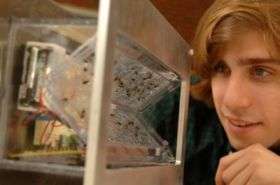Student engineers design environmentally safe, portable bug trap

It may not go “bzzzzzzt” but it does kill bugs — with less potential harm to the environment and people than traditional bug zappers.
An environmentally friendly bug trap designed in part by University of Florida engineering undergraduates uses battery-powered LEDs flashing at different frequencies to attract house flies. The flies make their way through slots in the trap toward the lights, only to become immobilized on a sticky glue strip in a disposable plastic cartridge.
“The combination of the different frequencies of light and the ultraviolet wavelengths is what does it,” said Hans Yeakel, a UF senior in industrial engineering. “They see that, and they want to come into the trap.”
Yeakel is one of six engineering seniors who designed the trap as part of the UF College of Engineering’s Integrated Product and Process Design Program. The program pairs student teams with corporate or government sponsors for yearlong design projects.
The problem with conventional bug zappers is that they blow up bugs into millions of tiny particles, said Yeakel and other team members. Research at Kansas State University and the University of Wisconsin has shown that these particles can hang around in the air for four days or more. The research has also shown that the particles can contain tiny bits of metal – also blown away when the bugs hit the zapper – and sometimes harbor live colonies of bacteria, Yeakel said. Both are a health concern, considering the common use of the zappers near homes, restaurants and businesses.
The students began working on the project after Niceville-based Nacon Technologies approached UF seeking assistance in tweaking the design of its light trap.
Jeffrey Brown, Nacon’s president and CEO, said he designed the first light-based insect traps in 1988 while director of technical development for Johnson Wax, now SC Johnson. After leaving the company, he founded Nacon to sell an improved version of the technology.
Wal-Mart, Disney and McDonald’s are among the companies that have expressed an interest in Nacon’s products, which have just begun to be manufactured in China, Brown said. Early this spring, Wal-Mart installed two Nacon traps at a Fort Myers store that is its largest in Florida to test the effectiveness of the traps in large stores, Brown said.
Brown said the current trap works well, but it has to be plugged in. He sought a portable, battery-operated trap because it could be placed anywhere for maximum effectiveness. Battery-powered traps also might appeal to the military, campers, emergency responders and others, he said. “Anyone who needs to be mobile could use it,” he said.
For Yeakel and the other students, the problem was that the plug-in traps currently use black light bulbs, which draw too much power to be battery operated.
The students tested cold cathode bulbs and LEDs instead. The cold cathode bulbs also required too much power. The tiny, silicon-based LEDs used far less power, but it took considerable research to nail down their best wavelength and flashing frequency to attract flies, Yeakel said. The students field tested their device at the U.S. Department of Agriculture’s insect laboratory on the UF campus. “It was pretty hard trying to get the flies attracted to it,” Yeakel said. “The physical components aren’t necessarily that complex, but when you’re dealing with a biological element, obviously it has a mind of its own.”
Eventually the team settled on a combination of ultraviolet and visible light flashing a repeating pattern of three different frequencies. Normal light bulbs flash at about 60 hertz, and the three differing frequencies appear to make the traps stand out to flies, the students said.
Tests showed the trap could attract as many as three dozen flies per hour with the lights off, although that number dropped when several lights illuminated the room, Yeakel said. Five flies per hour is considered good in high light environments, and the trap achieved that level or higher, he said. Still, “it’s something we need to work on,” he said.
The goal of the 12-year-old IPPD program is to assist corporations, small businesses and government agencies with engineering problems while giving future engineers practical experience. Another student on the bug trap team, Ryan Murray, said it succeeded in providing a unique educational environment. “It’s real-world experience, and it’s a lot more group oriented than most classes,” Murray said.
The other team members were Joshua Muriel, Tristan Aldinger, Raul Riveros and Anna Granovskaya. The team’s faculty adviser was Bill Eisenstadt.
Source: University of Florida





















